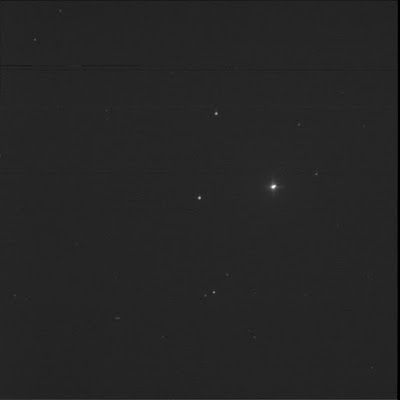BGO captured double-star ξ (xi) Boo (aiming at SAO 101256 to the east). Also known as Struve 1888, it is the bright pair to the right. It is a fast-moving binary system about 22 light-years away.
Luminance only, ½ second subexposures, 12 stacked shots. FITS Liberator, Paint.NET. North is up; east is left.
I intend to shoot this every May for a few years. The period is 152 years. Hopefully we'll see the orbital motion...
§
Now, when I first visually inspected this pair, I was after the colours. Σ1888 is noted in the RASC Observer's Handbook, the Cambridge Double Star Atlas, and the Coldfield list. Sky & Telescope magazine included it in an article regarding colours, if they were real or imagined.
Back in May 2008, I only noted the pair, A and B. Likely as that was all the information that I had to go on, at the time. It was before I started using SkyTools. Now, with ST3P, I know it is a multi-star system!
B is oriented to the west-north-west, tight, of course, to the primary.
The C companion is remarkably faint. I bet it is not visible to the eye at the ocular. It appears to the north-north-west, a good distance away. The Washington Double Star database reports it is mag 13.8.
Ally D is easily spotted, brighter than C. It is nearly inline with B, a touch further south, but further away than C. Two to three times the separation.
The E escort is opposite D, further out again. It is bright, possibly brighter than F. Maybe the same as B.
And finally the F star is to the north-east, the furthest. A tiny bit dimmer than E.
Cool. Wasn't expecting that...
§
Imaged again on 11 May 2020.



No comments:
Post a Comment